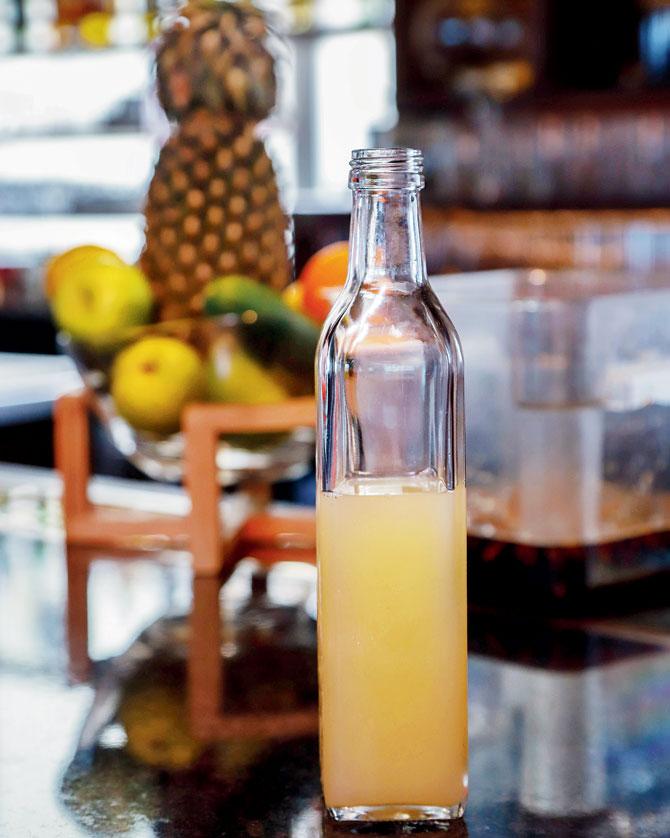Next time you eat a fruit, don't throw the rind. Ferment it to make fruit tepache instead. Bar consultant Nitin Tewari shows you how

Subham Gupta drains the tepache mixture, which is then left to ferment for three to four days
In the private dining area of Together At 12th, star bar consultant and mixologist Nitin Tewari's first space at Le Méridien Gurgaon, our eyes fall on the bookshelf filled with titles that make us drool. One hardback orange cover, particularly:
ADVERTISEMENT
The Noma Guide to Fermentation. At the bar that Tewari has co-founded with chef Vanshika Bhatia, R&D bar head Subham Gupta offers me a pineapple tepache, a Mexican beverage made by fermenting pineapple rinds. Today, chefs are using the technique to other fruits, too.
This takes us back to Noma's words in the book: "It tastes familiar, but also like nothing you have ever had before, like an old comfortable sweater with bright new colours woven through the original colours."

Nitin Tewari
Fermentation is one process that is turning chefs into geeks in their kitchens. It is a process where bacteria breaks down sugar to make alcohol. "When you leave food outside, we say it has gone bad. This is fermentation. The first alcohol was made when someone decided to drink something that had gone bad. When grapes went bad, we got wine. From barley we got beer," explains Tewari, who has in the past consulted at restaurants like Masque, Toast & Tonic, Olive Bar and Kitchen, and Rooh in San Francisco.
Fermentation can be of different kinds — aerobic, which is in the presence of air and anaerobic that takes place without oxygen. Here, carbon dioxide aerates
the liquid.
Making tepache or vinegar using natural bacteria or yeast from the air is easy to try at home. All you need is a little patience.
Taking the example of pineapple tepache, Gupta shows us a tumbler which has a muddle of dark amber liquid and pieces of pineapple skin. "We use the pineapple and throw away the skin, which actually has the bacteria needed to break the sugar and turn it into alcohol," says Gupta, who has also made a similar version of guava and wine.
We take a sip of pineapple tepache. It has the characteristics of pineapple fruit and an added elevated kick of astringent finish. In summer, fermenting a batch takes three to four days. "All you have to do is look out for bubbles, which means fermentation is underway. Keep the tumbler in a cool dry place and don't cover it for easy flow of oxygen. If you cover it and the carbon dioxide doesn't have an outlet, the mixture will aerate and there are chances the container will burst," says Tewari.

Pineapple tepache
Ingredients
1kg pineapple, 500gm unrefined sugar, 500ml water,
2 cinnamon stick, 2 cloves
Method
Muddle the pineapple, spices and sugar. Add water. Leave in contact with air for three to four days, depending on the temperature (longer for colder temperature). Once it starts bubbling on top, check for taste. Strain, bottle and refrigerate.
Fermenting tips
Salt tax: Lacto-fermentation, which uses salt and bacteria (lactobacillus) to work on the fruit, gives interesting results, too. "The lacto-fermentation process works because of the fact that bacteria that could be harmful to us, can't tolerate much salt, while healthy bacteria can," explains Tewari. While you can use the liquid and fruits for cocktails and mocktails, drinking and eating the fruit as garnish will benefit the gut.
Wine don't whine: Don't throw old wine. Tewari advices: let it worsen. "It is nothing, but fermentation. It can make for great vinegar that can be used in food. If you want to consume it like a drink, then stop the fermentation when the taste is not burning your throat. When it burns our throat, it's vinegar," says Tewari.
Catch up on all the latest Mumbai news, crime news, current affairs, and also a complete guide on Mumbai from food to things to do and events across the city here. Also download the new mid-day Android and iOS apps to get latest updates
 Subscribe today by clicking the link and stay updated with the latest news!" Click here!
Subscribe today by clicking the link and stay updated with the latest news!" Click here!






